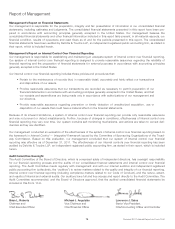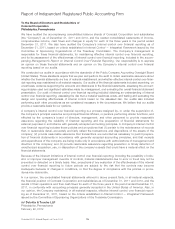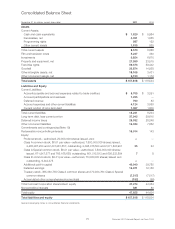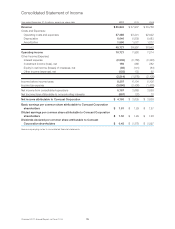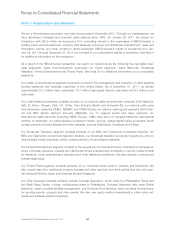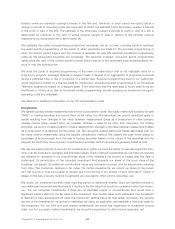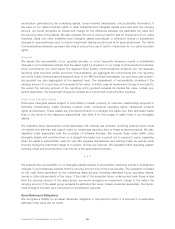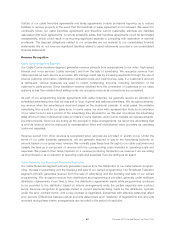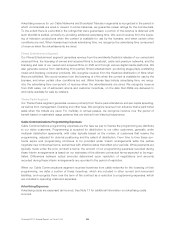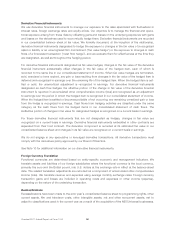Comcast 2011 Annual Report Download - page 86
Download and view the complete annual report
Please find page 86 of the 2011 Comcast annual report below. You can navigate through the pages in the report by either clicking on the pages listed below, or by using the keyword search tool below to find specific information within the annual report.investor owns an undivided copyright interest in the film and, therefore, in each period we record either a
charge or benefit to operating costs and expenses to reflect the estimate of the third-party investor’s interest
in the profit or loss of the film. The estimate of the third-party investor’s interest in profit or loss of a film is
determined by reference to the ratio of actual revenue earned to date in relation to the ultimate revenue
expected to be recognized over a film’s useful life.
We capitalize the costs of programming content that we license, but do not own, including rights to multiyear
live-event sports programming, at the earlier of when payments are made for the acquired programming or
when the license period begins and the content is available for use. We amortize capitalized programming
costs as the associated programs are broadcast. We amortize multiyear, live-event sports programming
rights using the ratio of the current period’s actual direct revenue to the estimated total remaining direct rev-
enue or over the contract term.
We state the costs of acquired programming at the lower of unamortized cost or net realizable value on a
program by program, package, channel or daypart basis. A daypart is an aggregation of programs broadcast
during a particular time of day or programs of a similar type. Acquired programming used in our Cable Net-
works segment is tested on a channel basis for impairment, whereas acquired programming in our Broadcast
Television segment is tested on a daypart basis. If we determine that the estimates of future cash flows are
insufficient or if there is no plan to broadcast certain programming, we will recognize an impairment charge to
operating costs and expenses.
SeeNote5foradditionalinformation on our film and television costs.
Investments
We classify publicly traded investments that are not accounted for under the equity method as available-for-sale
(“AFS”) or trading securities and record them at fair value. For AFS securities, we record unrealized gains or
losses resulting from changes in fair value between measurement dates as a component of other compre-
hensive income (loss), except when we consider declines in value to be other than temporary. For trading
securities, we record unrealized gains or losses resulting from changes in fair value between measurement dates
as a component of investment income (loss), net. We recognize realized gains and losses associated with our
fair value method investments using the specific identification method. We classify the cash flows related to
purchases of and proceeds from the sale of trading securities based on the nature of the securities and the
purpose for which they were acquired. Investments in privately held companies are generally stated at cost.
We use the equity method to account for investments in which we have the ability to exercise significant influ-
ence over the investee’s operating and financial policies. Equity method investments are recorded at cost and
are adjusted to recognize (i) our proportionate share of the investee’s net income or losses after the date of
investment, (ii) amortization of the recorded investment that exceeds our share of the book value of the
investees’ net assets, (iii) additional contributions made and dividends received, and (iv) impairments resulting
from other-than-temporary declines in fair value. For certain investments, we record our share of the invest-
ee’s net income or loss one quarter in arrears due to the timing of our receipt of such information. Gains or
losses on the sale of equity method investments are recorded to other income (expense), net.
We review our investment portfolio each reporting period to determine whether there are identified events or
circumstances that would indicate there is a decline in the fair value that would be considered other than tempo-
rary. For our nonpublic investments, if there are no identified events or circumstances that would have a
significant adverse effect on the fair value of the investment, then the fair value is not estimated. If an investment
is deemed to have experienced an other-than-temporary decline below its cost basis, we reduce the carrying
amount of the investment to its quoted or estimated fair value, as applicable, and establish a new cost basis for
the investment. For our AFS and cost method investments, we record the impairment to investment income
(loss), net. For our equity method investments, we record the impairment to other income (expense), net.
Comcast 2011 Annual Report on Form 10-K 84



